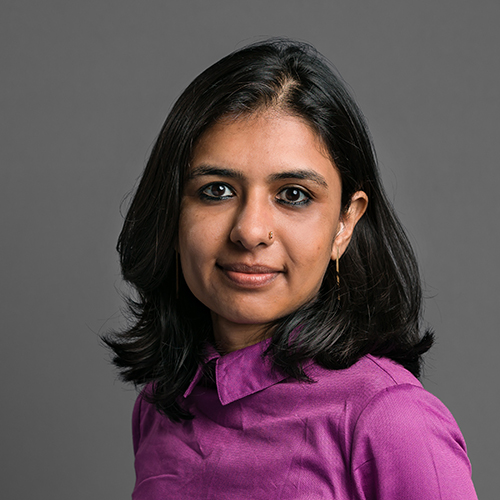“Literature from South Asia has had a moment of reckoning in 2022: things may never be the same again.”
Manasi Subramaniam, a 2022 Maurice R. Greenberg World Fellow and Editor-in-Chief at Penguin Random House India, is eminently qualified to talk about South Asian literature. In the 14 years since she entered the publishing industry, she’s published authors like Shehan Karunatilaka (author of The Seven Moons of Maali Almeida, winner of the 2022 Booker Prize), Geetanjali Shree (author of Tomb of Sand, winner of the 2022 International Booker Prize), Anuk Arudpragasam, Megha Majumdar, Deepa Anappara, and others. As a literary publisher, she has intensified efforts to bring literature written in regional languages to English-reading audiences. On Tuesday, November 29, Subramaniam joined the South Asian Studies Council for a lunchtime talk and conversation titled “Tombs, Ghosts, Djinns, Shadows: This Decade in South Asian Fiction.”
Subramaniam began by offering a brief overview of the scale of South Asia’s publishing industry: 19,000 books published every year in India alone, 90,000 publishers across the subcontinent, and a market that may be two-thirds bigger than currently understood. Since independence, she argued, South Asian publishing has experienced three distinct phases: textbook publishing (1950s to 1970s), independent publishers (1980s), and the entry of multinational publishing houses (since 1991). Using the award of the Booker Prize to South Asian authors, Subramaniam charted the rise of South Asian literature internationally, singling out a 14-year gap between Aravind Adiga’s The White Tiger winning the prize (2008) and 2022, when The Seven Moons of Maali Almeida won the Booker Prize and Tomb of Sand, translated from the Hindi by Daisy Rockwell, won the International Booker Prize. Subramaniam ascribed the gap to the twin emergence of a domestic South Asian (specifically Indian) market that loves genres like campus and mythological literature as well as the fact that South Asian literature in the 2010s began to chart the aspirations of a growing new middle class, a demographic that became both the primary readers and the primary subjects of subcontinental storytelling genres. Calling 2022 the biggest year in South Asian literature since the 1980s, and perhaps ever, Subramaniam said her inbox is now being flooded with interest from international publishers in South Asian writers. But she also emphasized the excruciating patience that has been required to achieve successes like Karunatilaka’s. Originally published by Subramaniam as Chats with the Dead in 2019, The Seven Moons of Maali Almeida took two years to find a publisher outside of India; Tomb of Sand was not published in the United States until after winning the International Booker Prize.
The talk gave way to a lively discussion as attendees reflected on Subramaniam’s arguments and insights. Professor Ayesha Ramachandran raised particular questions about the role of international and Western publishers and reviewers in arbitrating literary taste. “At what point are presses like Penguin and editors like you less interested in this international Western market that has preconceived notions about what Indian literature should be? I wonder to what extent that apparatus of reviewers remains deeply bifurcated?” Subramaniam candidly answered that “The problem is me,” explaining that she focuses on hardback literature, which is often also published internationally while paperback literature is published largely in domestic South Asian markets, and “the literary establishment relies on the Western seal of approval; the Booker means that everyone sits up and pays attention. That’s also part of the colonial hangover.”
Several other questions dealt with translation and the English language. Subramaniam said that “thirty percent of the fiction we publish is now translated literature because that is the only way we can break out of the stranglehold of English literature in India.” Subramaniam emphasized that more work is needed to find translators and translatable works, noting that Meena Kandasamy, an author who translated Salma’s Women, Dreaming from Tamil to English, was enthusiastic about translating the book despite being an internationally recognized poet and novelist in her own right. “She said, ‘Hell yes I’ll do it, how come no one’s ever asked me before?’” As the conversation came to a close, Subramaniam expressed confidence in English’s cross-cutting appeal and offered hope for the future of South Asian publishing: “I think the English language is a brilliantly inclusive language.”
Byline: Daevan Mangalmurti


